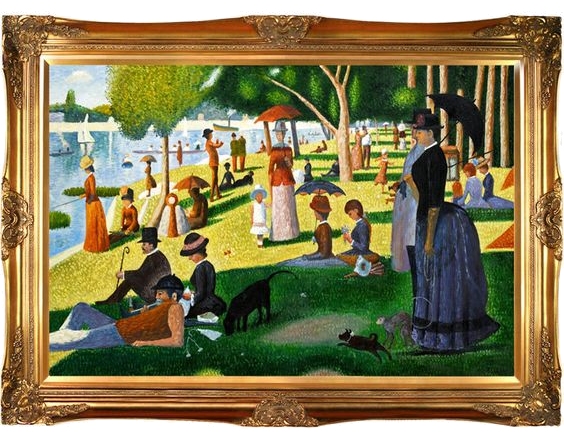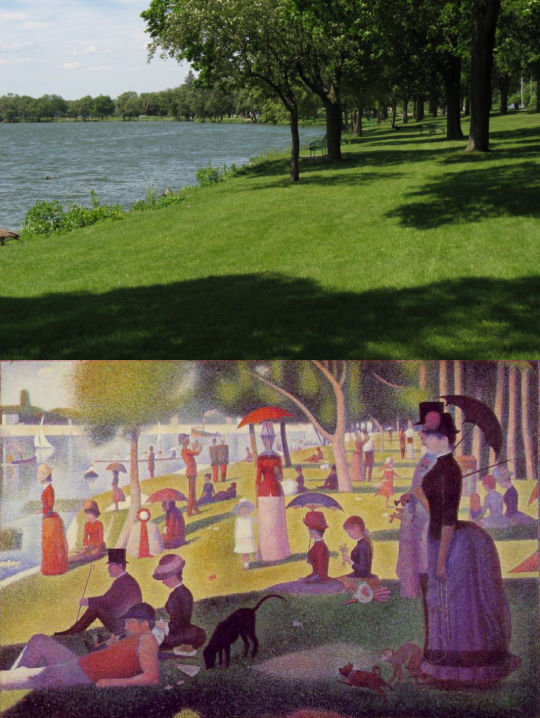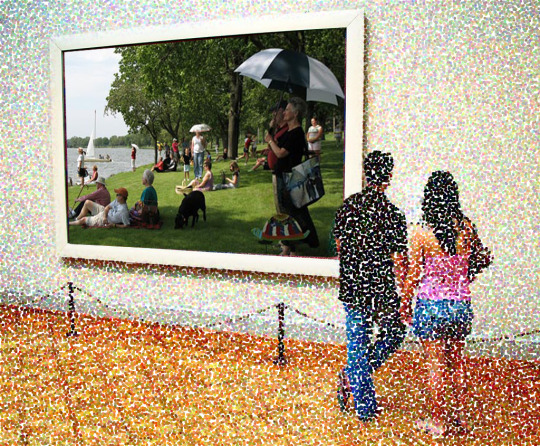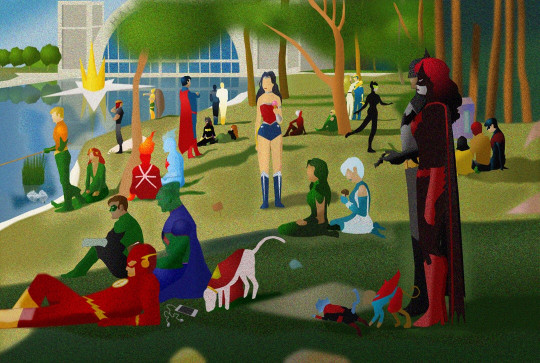15 Things You Might Not Know
About
Dimanche Après-Midi sur L'île de La Grande Jatte
Dimanche Après-Midi sur L'île de La Grande Jatte
Sunday Afternoon on the Island of La Grande Jatte


By Kristy Puchko - May 1, 2015
At first glance, Georges-Pierre Seurat's A Sunday on La Grande Jatte - 1884 seems
a warm portrait of a sunny day in a lovely park. But a closer look at
the Neo-Impressionist's most famous work reveals much more.
1. A Sunday on La Grande Jatte - 1884 is made up of millions of dots.
Forging the new style with this first-of-its-kind painting, Seurat became the father of Pointillism and of Neo-Impressionism. However, he preferred to call his technique "chromo-luminarism," a term he felt better stressed its focus on color and light.
2. It took Seurat more than two years to complete.
This complicated masterpiece of Pointillism began in 1884 with a
series of almost 60 sketches Seurat made while people watching at the
Paris park. Next he started painting, using small horizontal brush
strokes. After this initial work, he began the labor-intensive
realization of his vision with tiny dots of paint—a process that would
not be completed until the spring of 1886.
3. Science was Seurat’s major muse for color choices.
"Some say they see poetry in my paintings," Seurat said.
"I see only science." The artist was fascinated by the color theories
of scientists Michel Eugène Chevreul and Ogden Rood, and he explored
Divisionism in A Sunday on La Grande Jatte. This painting
method utilizes colors in patches that essentially trick the human eye
into blending them, creating luminance and shape.

4. Ancient Egyptian, Greek, and Phoenician art inspired the Parisian scene.
Seurat sought to capture the people of his Paris just as these eras immortalized their citizens. Or as he once put it to
French poet Gustave Kahn, "The Panathenaeans of Phidias formed a
procession. I want to make modern people, in their essential traits,
move about as they do on those friezes, and place them on canvases
organized by harmonies of color."
5. Critics initially hated it.
Seurat's groundbreaking techniques were a major turnoff for some
critics at the Impressionist exhibit where A Sunday on La Grande Jatte
debuted in 1886. Other observers sneered at the rigid profiles of
Seurat’s subjects. Meant to recall Egyptian hieroglyphics, these poses
were negatively compared to tin soldiers.
6. Sunday was revised in 1889.
Seurat re-stretched its canvas to allow for room to paint a border made up of red, orange and blue dots.
7. Seurat was just 26 when he completed his best-known work.
Thanks to his involvement in the artist collective the Société
des
Artistes Indépendants, the daring young painter's reputation was growing
before A Sunday on La Grande Jatte - 1884 debuted. But while his output
was seminal, it was also cut short in 1891 when Seurat died of an
undetermined disease at age 31.
 VIDEO
VIDEO
 VIDEO
VIDEO
8. Sunday was largely unseen for 30 years following Seurat's death.
The opportunity to view the historic painting returned in 1924 when art lover Frederic Clay Bartlett purchased A Sunday on La Grande Jatte - 1884 and loaned it indefinitely to the Art Institute of Chicago.
9. An American philosopher helped reshape public opinion on the painting.
In the 1950s, Ernest Bloch's three-volume The Principle of Hope
explored the socio-political interpretations of A Sunday Afternoon on
the Island of La Grande Jatte, spurring a renewed interest and
appreciation for the piece.
"This picture is one single mosaic of
boredom, a masterful rendering of the disappointed longing and the
incongruities of a dolce far niente [idleness]," Bloch wrote.
"The painting depicts a middle-class Sunday morning on an island in the Seine near Paris…despite the recreation going on there, seems to belong more to Hades than to a Sunday…The result is endless boredom, the little man's hellish utopia of skirting the Sabbath and holding onto it too; his Sunday succeeds only as a bothersome must, not as a brief taste of the Promised Land."
"The painting depicts a middle-class Sunday morning on an island in the Seine near Paris…despite the recreation going on there, seems to belong more to Hades than to a Sunday…The result is endless boredom, the little man's hellish utopia of skirting the Sabbath and holding onto it too; his Sunday succeeds only as a bothersome must, not as a brief taste of the Promised Land."
10. The painting is now displayed as Seurat intended.
Once he'd added his painted border, Seurat reframed A Sunday on La Grande Jatte in a specially-made wooden frame painted a crisp white. This display
choice is still in effect at the Art Institute of Chicago.
11. But its colors have changed.
Seurat employed a then-new pigment in his painting, a zinc chromate
yellow that he hoped would properly capture the highlights of the park's
green grasses. But for years this pigment has been undergoing a chemical reaction that began turning it brown even in Seurat's lifetime.
12. It's bigger than you'd think.
Not just Seurat's most popular piece, but also his biggest, A Sunday on La Grande Jatte
measures in at 81 3/4 inches by 121 1/4 inches, or about 7 feet by 10
feet. Its large size makes its every inch flush with tiny dots of color
all the more remarkable.
13. This park scene may hold hidden sex workers.
The titular locale was a favorite of prostitutes on the prowl, so some historians suspect
that fish are not what the fishing-pole-toting woman on the left was
hoping to hook. The same speculation has arisen around the lady on the
right, with a monkey on a leash and a man on her arm.
14. The painting was nearly incinerated while visiting New York.
On April 15, 1958, A Sunday on La Grande Jatte was on loan at the Museum of Modern Art in New York City when a fire broke out
in the adjoining Whitney Museum. The fire damaged six canvases, injured
31 people, and killed one workman, but Seurat's beloved work was
whisked away to safety through an elevator evacuation plan.
15. It's one of the most reproduced and parodied paintings in the world.
A Sunday on La Grande Jatte earns screen time in the Chicago-set comedy Ferris Bueller's Day Off, the science fiction cult classic Barbarella, and on the crude cartoon series Family Guy. It's been parodied by Sesame Street, The Simpsons, the American version of The Office, and even the cover of Playboy. In
Looney Tunes: Back in Action, Daffy Duck, Bugs Bunny and Elmer Fudd invade the painting. And celebrated Broadway icons Stephen Sondheim and James Lapine made a musical about its creation called,
Sunday in the Park With George.

Jake Gyllenhaal
Or something deeper than love - closer to religious gratitude - is the sentiment you may experience in the finale that concludes the first act of the marvelous revival of Stephen Sondheim and James Lapine’s “Sunday in the Park With George,” which opened on Thursday night at the newly restored Hudson Theater.
We
have watched a restless day of rest in the park of the title, where an
assortment of flâneurs and poseurs have become steadily more fractious
and discordant.

Jake Gyllenhaal, far left, and Annaleigh Ashford, far right, in “Sunday in the Park With George,” at the Hudson Theater. This tableau vivant - which mirrors the composition of Seurat’s most
celebrated painting, “A Sunday on La Grande Jatte,” and is repeated at
the end of the second act
"A Sunday Afternoon on the Island of La Grande Jatte" isn't just
Seurat's most famous painting, it is also one of the most famous and
frequently reproduced paintings in the world.
Like Leonardo da Vinci's "Mona Lisa," Salvador Dali's "The Persistence of Memory," and Edvard Munch's "The Scream," Seurat's painting is often reference in pop culture. Stephen Sondheim wrote a Tony award-winning musical
about it; the Looney Tunes, the Simpsons, and Sesame Street parodied
it; it appeared in "Barbarella" (1968) and "Ferris Bueller's Day Off"
(1986); and Nancy Cameron posed in front of a copy of it for the January
1976 issue of Playboy.
In 2006, the painting was recreated in modern clothes
in Beloit, WI. The recreation took place on a Saturday afternoon on the
bank of the Rock River to promote the "Saturday in the Park with
Friends" event.




A larger version of the painting is available here.


No comments:
Post a Comment